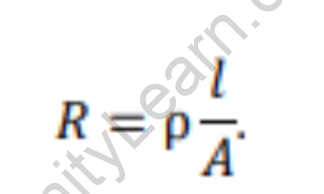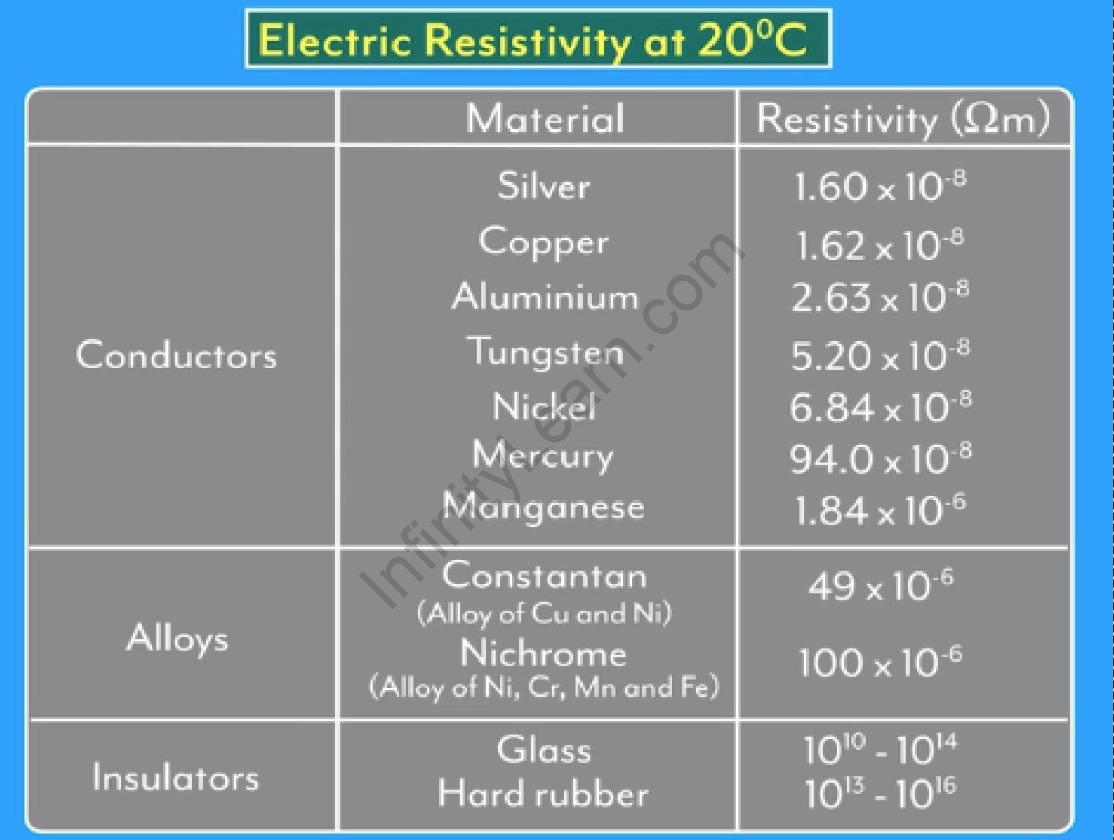Table of Contents
What is Electric resistivity?
- Resistivity is a factor in resistance that takes into account the nature of the material. It is a measure of how strongly a material opposes the flow of electric current.
- The resistance of a conductor is directly proportional to its length (l) and inversely proportional to its cross-sectional area (A). It also depends on the resistivity of the material (ρ).

- If the material has low resistivity, its resistance will be lower. And if it has more resistivity, its resistance will be higher.
Formula and Unit of Resistivity
The electric resistivity (ρ) of a material can be derived from its electrical resistance (R), cross-sectional area (A), and length (L). The resistivity represents the inherent resistance of a material to the flow of electric current.
The formula for resistance is given by Ohm’s Law: R = V/I, where V is the voltage across the material and I is the current flowing through it.
The formula for resistivity is derived by rearranging the formula for resistance and introducing the cross-sectional area and length of the material.
Resistance (R) = V/I
Resistance (R) = (ρL/A) × I, where ρ is the resistivity, L is the length, and A is the cross-sectional area.
Rearranging the equation, we get:
ρ = (R × A) / L
The resistivity (ρ) is equal to the resistance (R) multiplied by the cross-sectional area (A), divided by the length (L) of the material.
The SI unit of resistivity is the ohm-meter (Ω·m). Therefore, when the resistance is measured in ohms (Ω), the cross-sectional area is measured in square meters (m2), and the length is measured in meters (m), the resulting unit for resistivity is ohm-meter (Ω·m).
| Also Check | |
| Electric Current Formula | Linear Momentum Formula |
| Wavelength Formula | Electric Power Formula |
Resistivity in Different Materials
- Metals and alloys are good conductors of electricity since they have low resistivity.
- Non-metals like rubber and glass are bad conductors of electricity because of their high resistivity.

- The following table gives an idea about the resistivity of different materials at 20°C.

Electric resistivity of different materials at 20 degree Celsius
Solved Examples of Resistivity Formula
Example 1: A copper wire has a resistance of 2 ohms and a length of 10 meters. If the cross-sectional area of the wire is 0.01 square meters, calculate the resistivity of copper.
Solution:
Resistance (R) = 2 ohms
Length (L) = 10 meters
Cross-sectional Area (A) = 0.01 square meters
We can use the formula: Resistivity (ρ) = (Resistance × Cross-sectional Area) / Length
Resistivity (ρ) = (2 ohms × 0.01 square meters) / 10 meters
Resistivity (ρ) = 0.002 ohm-meter
Therefore, the resistivity of copper is 0.002 ohm-meter.
Example 2: A cylindrical rod made of a certain material has a resistivity of 5 ohm-meters. If the rod has a length of 2 meters and a cross-sectional area of 0.02 square meters, determine its resistance.
Solution:
Resistivity (ρ) = 5 ohm-meters
Length (L) = 2 meters
Cross-sectional Area (A) = 0.02 square meters
We can rearrange the formula: Resistance (R) = (Resistivity × Length) / Cross-sectional Area
Resistance (R) = (5 ohm-meters × 2 meters) / 0.02 square meters
Resistance (R) = 500 ohms
Therefore, the resistance of the cylindrical rod is 500 ohms.
Example 3: A wire made of a certain material has a resistance of 10 ohms and a resistivity of 2 ohm-meters. If the length of the wire is 5 meters, find the cross-sectional area of the wire.
Solution:
Resistance (R) = 10 ohms
Resistivity (ρ) = 2 ohm-meters
Length (L) = 5 meters
We can rearrange the formula: Cross-sectional Area (A) = (Resistance × Length) / Resistivity
Cross-sectional Area (A) = (10 ohms × 5 meters) / 2 ohm-meters
Cross-sectional Area (A) = 25 square meters
Therefore, the cross-sectional area of the wire is 25 square meters.
Frequently Asked Questions on Resistivity Formula
What is resistivity?
Resistivity is a fundamental property of a material that quantifies its inherent resistance to the flow of electric current. It is denoted by the symbol ρ (rho) and is measured in ohm-meters (Ω·m). Resistivity depends on various factors such as the nature of the material, temperature, and impurities.
How is resistivity different from resistance?
Resistance (R) is a measure of how much a specific object or component resists the flow of electric current. It depends on the dimensions and properties of the object. Resistivity (ρ), on the other hand, is an intrinsic property of the material itself and is independent of the size or shape of the object. Resistivity is used to characterize the material's resistance behavior.
How does temperature affect resistivity?
In general, the resistivity of most materials increases with an increase in temperature. This is due to the increased scattering of charge carriers, leading to greater resistance to the flow of current. However, this behavior can vary depending on the material. Some materials, such as semiconductors, may exhibit decreased resistivity with increasing temperature.
What factors affect the resistivity of a material?
The resistivity of a material is influenced by factors such as temperature, impurities, crystal structure, and electron mobility. Impurities and defects can increase the resistivity, while higher electron mobility and regular crystal structure tend to lower the resistivity.
How is resistivity related to conductivity?
Resistivity (ρ) and conductivity (σ) are inversely related. Conductivity is the reciprocal of resistivity, represented as σ = 1/ρ. Materials with high conductivity have low resistivity and vice versa. Conductivity is a measure of how well a material conducts electric current.
Why is resistivity an important property of materials?
Resistivity is a critical property in electrical and electronic applications. It helps determine the suitability of a material for specific purposes, such as selecting conductors or insulators. Resistivity is also used in circuit design, calculating power dissipation, and understanding the behavior of electrical components and systems.
How is resistivity measured experimentally?
Resistivity can be measured using various techniques, such as the four-point probe method or the Van der Pauw method. These methods involve passing a known current through a sample and measuring the voltage across it to determine the resistance. The dimensions of the sample, such as length and cross-sectional area, are also measured to calculate the resistivity.







